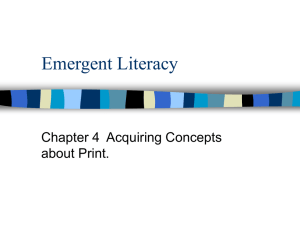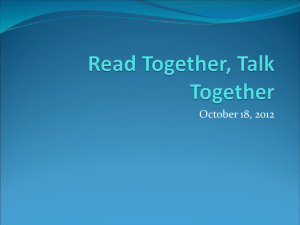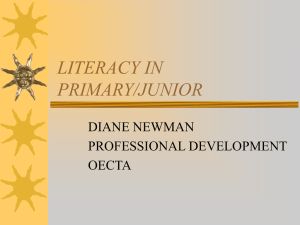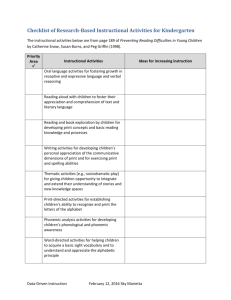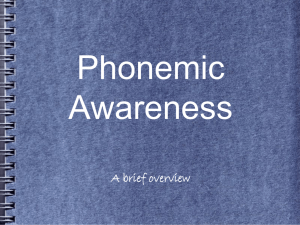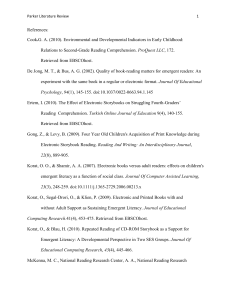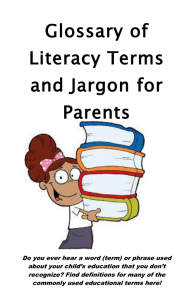- Northern Lights School Division #113
advertisement
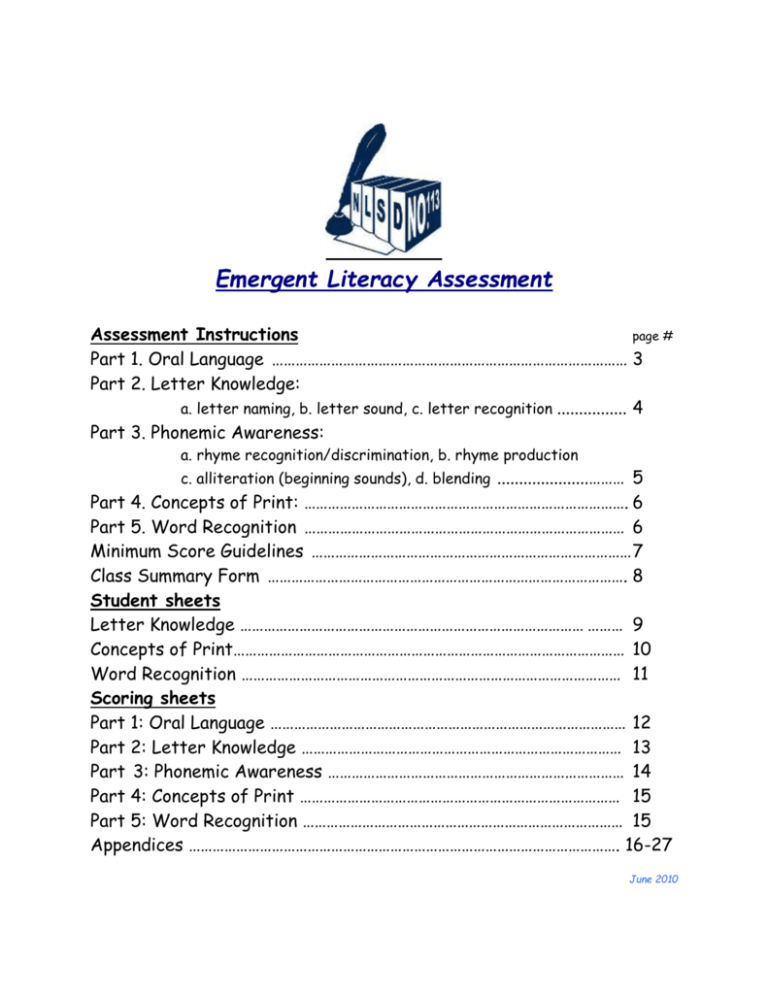
Emergent Literacy Assessment Assessment Instructions page # Part 1. Oral Language ……………………………………………………………………………… 3 Part 2. Letter Knowledge: a. letter naming, b. letter sound, c. letter recognition ................ 4 Part 3. Phonemic Awareness: a. rhyme recognition/discrimination, b. rhyme production c. alliteration (beginning sounds), d. blending .....................……… 5 Part 4. Concepts of Print: ………………………………………………………………………. 6 Part 5. Word Recognition ……………………………………………………………………… 6 Minimum Score Guidelines ……………………………………………………………………… 7 Class Summary Form ………………………………………………………………………………. 8 Student sheets Letter Knowledge …………………………………………………………………………… ……… 9 Concepts of Print……………………………………………………………………………………… 10 Word Recognition …………………………………………………………………………………… 11 Scoring sheets Part 1: Oral Language ……………………………………………………………………………… 12 Part 2: Letter Knowledge ……………………………………………………………………… 13 Part 3: Phonemic Awareness ………………………………………………………………… 14 Part 4: Concepts of Print ……………………………………………………………………… 15 Part 5: Word Recognition ……………………………………………………………………… 15 Appendices ………………………………………………………………………………………………. 16-27 June 2010 Emergent Literacy Assessment - Instructions Pg. 2 NLSD#113 Emergent Literacy Assessment A. Screening/Diagnostic assessment - For all students at the end of kindergarten and/or beginning of grade one. For students in other grades who are at emergent reading levels B. Intervention Appendix A (p.16) - 100 High Frequency Words Appendix B (p.17) - Oral Language Lesson Planning Guide Appendix C (p.19) - Phonemic Awareness Lesson Planning Guide C. Progress Monitoring - Re-assess students who have been receiving intervention guided instruction in oral language and phonemic awareness (Tier 1/Tier2) See Appendix D (pages 23-26) for extra/optional scoring sheets for progress monitoring assessment Emergent Literacy Assessment - Instructions Pg. 3 Part 1: Oral Language Assessment The language structures included in this assessment are vital for students to understand if they are to make meaning of classroom instructions, discussions, and stories that are read to them, and if they are to construct meaningful texts. Analysis of how the student handles the sentences he or she is unable to repeat provides important insights. Directions: 1. Find a quiet location, out of the hearing of students who will be tested later. Extra support may be needed to do this – to either monitor the class, or give the assessment outside of the classroom. 2. Have the student’s full attention throughout this assessment (if attention should wander, gently redirect the student back to the task before moving to the next sentence). 3. Read each sentence to the student using the phrasing indicated by the bold italics. Speak clearly with natural tone and pace. 4. Familiarize the student with the testing procedure. Tell the student, I am going to read some sentences, and I would like you to say exactly what I say. Let’s begin. “Sally is walking to her house.” Very good. Let’s try this one. “Where are you going?” Okay. Say these... Procedure: Begin at Set 1 (pg.12). Administer the sentences in order from 1 to 5. Record the student’s response directly on the scoring sheet, much as one would record a running record. Continue to Set 2 and Set 3 in the same way. Scoring: Score one point for each sentence repeated correctly in every detail. Score zero points for sentences with one or more errors. Interpreting Data to Inform Instruction: Administer the assessment as early in the school year as possible to all grade 1 students. The assessment should also be administered for all students new to the school or for whom there are concerns regarding language, including students whose reading comprehension is lagging well behind text accuracy. Hearing and speech problems may also be identified through the oral language assessment. See: Appendix B Oral Language Planning Guide for guided instruction. Appendix C Phonemic Awareness Planning Guide for guided instruction Emergent Literacy Assessment - Instructions Pg. 4 Part 2: Letter Knowledge Assessment Provide student with a copy of the letter page (Student Sheets – Pg. 9) Allow the student to use either upper or lower case letters, or both. Allow the student to approach this task in his/her own way. S/he may: o point to one letter at a time in a sequential fashion and name it. o point only to letters s/he knows in a random fashion o call the letters by their names, or identify them by one of the sounds the letter makes or a word that starts with that letter Accept all responses and record how the student approached the task. Record all responses without comment. (Scoring Sheet pg.13) a. Letter Naming Say, “Can you tell me the names of any of these letters?” b. Letter-sound Knowledge Say, “Can you tell me the sounds of any of these letters?” c. Letter Recognition (Optional – may be completed if student is weak with letter naming) Say, “I’m going to say the names of some of these letters. Will you see if you can find and point to the letters I say?” Additional progress monitoring scoring sheets for Letter Knowledge Assessment are in Appendix D: pg.24 –Part 2(a) Letter Recognition, pg.25 – Part 2(b) Letter Naming and Letter-sound Knowledge Emergent Literacy Assessment - Instructions Pg. 5 Part 3: Phonemic Awareness Assessment Note: Give the student the examples and complete the task before proceeding with the next category. Accept all responses. Give 1 point for each correct answer (pg.14). a. Rhyme Recognition/Discrimination Directions: “I’m going to say two words and ask you if they rhyme. Listen carefully.” Demonstration Items: “Fan rhymes with man. Do these words rhyme?” rat ~ mat leg ~ lot mitt ~ fit “Do these words rhyme? ______~______” 1. book ~ look 2. fun ~ run 3. ring ~ rat 4. box ~ mess 5. fish ~ dish b. Rhyme Production Directions: “I’m going to say a word and I want you to tell me a word that rhymes with it. You can make up a word if you want to.” Record the student’s response. Demonstration Items: “Tell me a word that rhymes with bat.” miss log “Tell me a word that rhymes with _____” 1. cat 2. pot 3. tame 4. bee 5. kite c. Awareness of Alliteration (Beginning Sounds) Directions:” I’m going to say two words. Listen very carefully to the first sound in each word and tell me if the words start with the same sound. If you’re having trouble hearing the first sound in the word repeat them after I say them with your own mouth and feel the sound that your mouth is making at the start of each word. Say “yes” if these words start with the same sound. Say “no” if they don’t start with the same sound” Demonstration Items: “Do these two words start with the same sound?” Bug ~ ball pill ~ rat “Do these two words start with the same sound?” 1. big 2. come 3. funny 4. dog balloon colour morning deer 5. silly hat d. Blending Directions: “I’ll say the sounds of a word. You guess what the word is.” Demonstration Items: What word is this? i-t d-o-g “What word is this? _____________” 1. u-p 2. b-oy 3. c-a-t 4. s-i-t 5. t-ai-l Emergent Literacy Assessment - Instructions Pg. 6 Part 4: Concepts of Print Directions: Give the student a copy of the Concept Page (Student Sheets – Pg. 10) and ask the following questions. Give 1 point for each correct answer. (Scoring Sheet pg.15) 1. Where is the number? 2. Where is the square? 3. Where is one letter all by itself? 4. Where is the picture? 5. Where is one word all by itself? 6. How many letters do you see in that word? 7. Where do you see some sentences? 8. If I were reading these sentences (Point to the sentences), show me where I would start reading them. 9. & 10. Show me by pointing with your finger, which way to go to read these sentences. (left to right = 1 point, return sweep = 1 point) Part 5: Word Recognition Directions: Use a list of 10-25 words - From the included Frequently Used Word List (Student Sheets – pg. 11) and/or other words from the High Frequency Words List (Appendix A). Give the student the copy of the word list. Ask them to look at the word list and find and read all of the words that they know. Score words read correctly and record what word was substituted beside any words that were attempted and read incorrectly. (Scoring Sheet pg. 15) After administration of the assessment note to what extent substitutions make use of letter-sound knowledge. Include under “Comments” how confidently the student approaches decoding words in isolation and his/her ability to recognize features of words, take words apart, use word family knowledge etc. Emergent Literacy Assessment - Instructions Pg. 7 Minimum Guidelines For Guided Reading Preparedness AREA ASSESSED 1. Oral Language Assessment SCORE Minimum Guidelines For Guided Reading Preparedness /15 Score of at least 5 /26 Score of at least 20 /26 Score of at least 10 3. Phonemic Awareness /20 Score of at least 10 4. Concepts of Print /10 Score of at least 7 5. Word Recognition /12 Score of at least 2 2. Letter Knowledge Sound Knowledge Oral Language Assessment: Repeat My Sentence Scoring Rubric > intervention range guidelines for grades 1,2,3 0-4 = this student has limited control over structures of oral English – unable to follow simple instructions or a story read in class. This student needs intensive small-group oral language intervention. 5-10 = if in grade 2, this student is at-risk and requires intensive small-group instruction in oral language- reading and oral language -writing 11-14 = if in grade 3, this student is at-risk and requires intensive small-group instruction in both oral language –reading and oral language - writing References: Early Literacy: A Resource for Teachers. Saskatchewan Education. 2000. English Language Arts: A Curriculum Guide for the Elementary Level. Saskatchewan Education 2002 Teaching Students with Reading Difficulties and Disabilities. Saskatchewan Education. 2004 Let’s Talk About It! A Guidebook for Instruction. Mondo Publishing. 2004 Early Success: Overview of Emergent Literacy. Houghton Mifflin Three Tiers of Instruction and Intervention for Reading. Dawn Reithaug, 2009. Emergent Literacy Assessment - Instructions Pg. 8 Word Recognition Concepts of Print Phonemic Awareness Sound Knowledge Letter Knowledge Students: Oral Language Assessment Class Emergent Literacy Assessment Summary Form /15 /26 /26 /20 /10 /12 /15 /26 /26 /20 /10 /12 /15 /26 /26 /20 /10 /12 /15 /26 /26 /20 /10 /12 /15 /26 /26 /20 /10 /12 /15 /26 /26 /20 /10 /12 /15 /26 /26 /20 /10 /12 /15 /26 /26 /20 /10 /12 /15 /26 /26 /20 /10 /12 /15 /26 /26 /20 /10 /12 /15 /26 /26 /20 /10 /12 /15 /26 /26 /20 /10 /12 /15 /26 /26 /20 /10 /12 /15 /26 /26 /20 /10 /12 /15 /26 /26 /20 /10 /12 /15 /26 /26 /20 /10 /12 /15 /26 /26 /20 /10 /12 /15 /26 /26 /20 /10 /12 /15 /26 /26 /20 /10 /12 Emergent Literacy Assessment – Student Sheets Pg. 9 T S B G O A D M R H K L W F P Y C E Z I Q V N X U J t s b g o a d m r h k l w f p y c e z i q v n x u j Emergent Literacy Assessment – Student Sheets Pg. 10 Dog 4 B The boy got on the bus. He went to school on the bus. The boy liked to play with his friends. Emergent Literacy Assessment – Student Sheets Pg. 11 the to red play big it my is no can and go Name: _______________________________ Grade: ____ Age: ____ Date: _______ p.12 Part 1: Oral Language Assessment Set 1 1. The puppy’s tail is curl y. ___ 2. Mommy is baking a cake. ___ 3. The teacher told them a story. ___ 4. There are the children . ___ 5. She’s eating her lunch slowl y. ___ Subtotal Set 2 1. That red bike over there used to be my uncle’s . ___ 2. The girl in the ca r is waving her hand. ___ 3. Over the weekend Jane brought us some cookies . ___ 4. Here comes the machine that digs the big holes. ___ 5. The bird built a nest high in the tree . ___ Subtotal Set 3 1. Be ready to come inside when the bell rings . ___ 2. The car and the truck were carrying some large boxes . ___ 3. The brave fireman showed our class the big red truck . ___ 4. There go the men who clean the playground at our school. ___ 5. My friend likes to eat ice cream when it’s very hot out . ___ Subtotal TOTAL SCORE: / 15 Pg. 13 T t S s B b G g O o A a D d M m R r H h K k L l W w F f P p Y y C c E e Z z I i Q q V v N n X x U u J j Letter Score Summary: Recognition: /26 Naming: / 26 Sounds: Recognition (Optional) LetterSound Knowledge Naming Letter Recognition (Optional) LetterSound Knowledge Naming Letter Part 2: Letter Knowledge / 26 Pg. 14 Part 3: Phonemic Awareness Rhyme Production Rhyme Recognition Correct Response Score Response book ~ look yes cat fun ~ run yes pot ring ~ rat no tame box ~ mess no bee fish ~ dish yes kite ___ /5 ___ /5 Blending Awareness of Alliteration Correct Response big balloon yes come colour yes funny morning no dog deer yes silly hat no Score Response Score Score u-p b-oy c-a-t s-i-t t-ai-l ___ /5 ___ /5 TOTAL SCORE: /20 Pg. 15 Part 4: Concepts of Print Part 5: Word Recognition Concepts of Print Word Recognition Score Response/Score 1. Number the 2. Square to 3. Letter red play 4. Picture big 5. Word it 6. Letters in word my 7. Sentences is 8. Reading starting point no 9. Left-Right Directionality can 10. Return Sweep and /10 go /12 General Comments & Observations: ______________________________________________ ______________________________________________ ______________________________________________ ______________________________________________ ______________________ name of recorder Northern Lights SD#113 Pg. 16 100 High Frequency Words 1 2 3 4 5 6 7 8 9 10 11 12 13 14 15 16 17 18 19 20 21 22 23 24 25 the of and a to in is you that is he was for on are as with his they I at be this have from 26 27 28 29 30 31 32 33 34 35 36 37 38 39 40 41 42 43 44 45 46 47 48 49 50 or one had by word but not what all were we when your can said there use an each which she do how their if 51 52 53 54 55 56 57 58 59 60 61 62 63 64 65 66 67 68 69 70 71 72 73 74 75 will up other about out many then them these so some her would make like him into time has look two more write go see 76 77 78 79 80 81 82 83 84 85 86 87 88 89 90 91 92 93 94 95 96 97 98 99 100 Appendix A number no way could people my than first water been call who its now find long down day did get come made may part over This chart is from Three Tiers of Instruction and Intervention for Reading pg. 302 by Dawn Reithaug (2009) Also see Student Center Activities: Phonics/High Frequency Words at The Florida Center for Reading Research http://www.fcrr.org/Curriculum/PDF/G2-3Phonics_2pdf Pg. 17 Appendix B Emergent Literacy Oral Language “Let’s Talk About It” PLANNING GUIDE date/ timeframe:_________________________________ Day 1 Day 2 Day 3 Shared* Viewing & A. Generating a B. Recording their C. Return to their Response Discussion Thoughts Thoughts __ Visual Image __ Other Goal: for students to know that what they think they can say. Title or topic of Shared text or image: - Accept all attempts (not a time for formal __________________ correction of grammar), to build * use confidence students pictures/illustrations must feel that their that all students in ideas are accepted group can see clearly. “as is” - Encourage talk about the picture(s) without hurry; wait time must be sufficient to allow students time to think and say what they are thinking - After students have generated a number of ideas about the picture, help the students select the ideas to record. - Scribe the actual words of the students onto chart paper - Discuss personal connections, predictions, thoughts & ideas... Goal: for students to know that what they think can be said, what is said can be written down, what is written down can be read back. - Look again at recorded ideas from day before - re-read the text together many times (teach fluency from the start) - Introduce/reinforce print concepts (one-toone correspondence, directionality, starting points, top to bottom of page etc.) (not question/ answer or correcting language – joining in the - recall who had ideas may make jot-notes for discussion and getting future discussion) comfortable with expressing ideas is the focus!) - use prior knowledge: relate what they hear/see to their own experience - share ideas to build comprehension - express interest and joy in viewing & responding - listen to others - join in and contribute to shared language experiences - talk about experiences, make comments, ask questions - share ideas and feelings - participate in shard reading - recognize that oral language can be written down - how language works in print and how print is structured helps to create meaning – Do not record responses yet (teacher Oral Language Objectives Focus Goal: for students to know that what they think they can say and what they say can be written down. Pg. 18 Appendix B (notes) Oral Language Development Note: An essential foundation for the development of reading and writing abilities is that of strong oral language capabilities including: > Vocabulary and concept development – information about word meanings (semantics) and pronunciation of words (phonemics) > Understanding the ways that language conveys meaning through such aspects of structure as word order and the rules for subjectverb agreement (syntactics) > Understanding conventional and culturally specific ways to communicate with others (pragmatics) > Desire and ability to use speech for a variety of purposes. In a print-rich environment, understanding of written and spoken language develop together. Teachers need not postpone early exposure to a variety of experiences with written language while supporting oral language development. Activities that isolate vocabulary development from its immediate application for real purposes are not recommended because they appear to have limited carry-over [transference]... Teaching strategies [should] develop oral language capabilities within meaningful contexts and concrete experiences. From: Early Literacy: A Resource for Teachers. Chapter One: Supporting Oral language Development. Saskatchewan Education (2000) Pg. 19 Appendix C Emergent Literacy Phonemic Awareness Guided Reading Planning Guide date/timeframe:_________________________________ Shared* Reading/Viewing __ Poem __ Story __ Visual Image __ Other Title of shared text or image: _____________ * use text that all students in group can see clearly. (if visual image or wordless book scribe students’ dictated description on chart paper) Phonemic Awareness (auditory activity) Before / During/ After Reading Monday / Day 1 Tuesday / Day 2 Wednesday/ Day 3 Thursday/ Day 4 Friday/ Day 5 Comprehension Vocabulary - Revisit Text Read aloud, track print, and encourage students to join in where text is repetitive and predictable. - Clarify as words occur, “think-aloud” to model wordsolving strategies, and encourage student attempts to figure out word meanings from context. - Use Word Print Conventions, Visual Cues, Fluency Phonological Patterns Processing Info - Reread the text aloud together. – - Before Reading Introduce Story: predict, make connections & set purpose for reading. - Read aloud with flow and enjoyment. - After reading, ask literal and inferential questions (include inference from pictures) and discuss personal connections to the text. - Encourage talk about the book and/or pictures Hunts & Oral Cloze etc. - Revisit text – Look at first few pages and focus on book/ print conventions that affect reading. - Model use of visual info. (punctuation, font type, text features) - Re-read the text aloud all together: all students join in to develop fluency, practice conventions and ‘read’ visual information - Revisit text and read the entire text aloud together without pausing and with enthusiasm. - Use a few pages to focus on phonological patterns. - Hunt for other examples of the letter pattern (i.e. use magnetic letters or whiteboard to make words) - Play with words by repeating them in different ways (choral, echo, soft/loud, high/low...) Students retell using props (i.e. pictures, felt shapes, pocket chart) - Focus on sequence (beginning, middle, end), story elements (characters, setting, problem/ solution), theme (compare with other stories). - Response activity (i.e. role-play to act out story or parts of it, drawing or sorting pictures/ letters/words. - Present student responses Rhyme - Alliteration - Sentence - Syllable - Phoneme Recognition Identification/ Segmentation Segmentation Segmentation Rhyme Discrimination - Compound & Blending & Blending Production - Identify Initial Word - Identify Final Sound in a Segmentation Sound in a word word Tap prior knowledge, predict, Share ideas, Express interest, Practice word strategies, Explore Meaning Text Structure/Print conventions, Graphophonics, Phonemic Awareness, Retelling – comprehension, story structure Students: _________________________________________________________________________ Pg. 20 Appendix C con’t. Recommended Resources for Phonemic Awareness development: 1. A Resource Manual for Teaching Phonemic Awareness Skills in the Early Grades by Barbara Elliot (1994, 1996) - Kindergarten Activities 2. Early Literacy: A Resource for Teachers. Saskatchewan Education (2000). Pgs. 82-93. 3. Teaching Students with Reading Difficulties and Disabilities: A Guide for Educators. Saskatchewan Learning (2004) Pg. 38, Appendix B pgs. 105-125. 4. Orchestrating Success in Reading by Dawn Reithaug (2002) dreithaug@shaw.ca 5. Road to the Code: A Phonological Awareness Program for Young Children. Blachman, Ball, Black & Tangel (1999) Brookes Publishing (1-800-638-3775) 6. Animated Literacy. Jim Stone (2002) jstone@yahoo.com 7. Kindergarten Teacher’s Resource Book, Nelson Language Arts program (2000) Nelson Thomson Learning Teaching Students with Reading Difficulties and Disabilities: A Guide for Educators pg.106 Hierarchy of Phonemic Awareness Skills: In order to provide appropriate intervention, it is important to understand the hierarchy of skills involved in phonemic awareness. Skills must be taught beginning with simple skills and moving toward more complex skills. Skills are listed from simple to complex 1. Rhyme Recognition The ability to identify if a pair of words rhyme. For example, do pat and fat rhyme? (yes) Do fox and fairy rhyme? (no). 2. Rhyme Production The ability to produce a rhyming word. For example, tell me a word that rhymes with “kiss”, “cat”, “dog”. 3. Alliteration Identification The ability to identify the common sound in different words. For example, tell me the sound that is the same in baby, bark, big (/b/). 4. Alliteration Discrimination The ability to identify the word that has the odd sound. For example, tell me which word does not belong in bake, bug, and rat (rat). Pg. 21 Appendix C con’t. 5. Sentence Segmentation The ability to identify individual words in a sentence. For example, clap for each word you hear in a sentence, “I love you”. The child should clap three times. 6. Segmenting Compound Words The ability to identify that some big words are made up of two little words. For example, clap one time for each little word you hear in this big word: “mailbox”, “snowman”. 7. Segmenting Words into Syllables The ability to identify the number of beats or syllables in a word. For example, say a word and have the child clap one beat for each syllable: “cat” (1), “garden” (2), “dinosaur” (3), “dysfunctional” (4). 8. Blending Syllables The ability to blend parts of words. For example, say “cup–cake” with a slight pause between the two words. Ask the child to identify the whole word–(cupcake). Other examples are “pen–cil” and “hap–py”. 9. Segmenting Phonemes The ability to identify the individual sounds in a word. For example, ask the child to say the word “cat” and place a block on the table for each sound in the word “c – a – t” (3), “f – l - a – g” (4), or “g – o” (2). 10. Blending Phonemes The ability to blend phonemes or individual sounds in a word. Begin with two to three phonemes and progress to four. For example, say “g – o” or “s – oa – p” with a slight pause between each sound and ask the child to identify the word. 11. Identifying the Initial Sound in a Word The ability to identify the first sound heard in a word. For example, ask the child to identify the first sound in the word “time” /t/. 12. Identifying the Final Sound in a Word The ability to identify the last sound heard in a word. For example, ask the child to identify the last sound in the word “time” /m/. 13. Identifying the Medial Sound in a Word The ability to identify middle sound heard in a word. For example, ask the child to identify the middle sound in the word “time” /i/. 14. Deleting a Phoneme The ability to manipulate the individual sounds of a word. For example, say the word “bat” and say it again without the /b/ (/at/). 15. Adding a Phoneme The ability to add a sound to a group of sounds or to a one syllable word. For example, if you add the /b/ sound to /at/ you say “bat”. Add the /h/ sound to /it/ “hit” or add the /p/ sound to /op/ “pop”. 16. Substituting the Initial Phoneme in a Word: The ability to change the first sound in a word. For example, say the word “cat” and then say it again with /b/ for /k/. You then have “bat” instead of “cat”. 17. Substituting the Final Phoneme in a Word The ability to change the last sound in a word. For example, say the word “bit” and then say it again with /d/ for /t/. You then have “bid” instead of “bit” Pg. 22 . Appendix C con’t. 18. Substituting the Medial Vowel Phoneme in a Word The ability to change the middle sound in a word. For example, say the word “bad” and then say it again with /u/ for /a/. You then have “bud” instead of “bad”. Adapted from Ericson, & Juliebö (1998), Feifer, & De Fina (2000), Mather, & Goldstein (2001), Reithaug (2002). Teaching Students with Reading Difficulties and Disabilities: A Guide for Educators Recommendations for Teaching Phonemic Awareness Skills The following suggestions are provided to assist teachers when teaching phonemic awareness skills. • It is critical to identify children early who are at risk for reading difficulties so that preventative work can begin as soon as possible. • Some students will need instruction at the emergent levels (rhyming, segmenting, and blending) to the more complex levels (substituting and deleting sounds). Create “mini” lessons to meet the needs of students in your class. • Segmentation or blending tasks are easier with continuant phonemes (e.g., /s/, /sh/, /l/) than with non continuant-stop phonemes (e.g., /p/, /b/, /t/). • Phonemic awareness activities have a greater impact on reading success when combined with instruction in letter-sound correspondence. • Not all students will acquire skills at the same rate. Intervention for a certain skill needs to be as long as necessary to support a student’s acquisition of the skill. • When multiple tasks in phonemic awareness are the objective, teach one or two until each is mastered before moving to the next. • Teach phonemic awareness in a small group setting. • Teach students an average of 15 to 20 minutes per day. • Some struggling readers will need to have intensified intervention in phonemic awareness if they have not developed this ability. • The relationship between learning about phonemes and developing decoding skills is reciprocal. • When teaching individual phonemes, orally model the sound and draw attention to how the sound is produced in the mouth. For example, ask the child how did the sound feel? Did your vocal chords vibrate? Did air come out of your mouth? What did your tongue and lips do? • When students segment sounds in words, they can represent the sounds with something concrete (blocks), visual cues (holding up fingers), kinesthetic cues (jumping), or auditory cues (clapping). Using a multi-sensory approach improves children’s ability to segment. • Phonemic awareness skills can be taught and enhanced through natural language development. Create spontaneous games and activities by using, songs, nursery rhymes, poems, and stories. • Ericson and Juliebo (1998) reported that kindergarten children instructed in both segmenting and blending skills performed significantly better on all tests of sound association and word recognition than children taught in phoneme analysis (segmenting) alone. Adapted from National Institute of Child Health and Human Development (2000); Reithaug (2002) Pg. 23 *Progress Monitoring- optional extra Scoring Sheets for Tier 2 Assessment Appendix D Emergent Literacy Part 1: Oral Language Assessment alternative sets for progress monitoring Student: ___________________________________________________________ Grade: ___ Set 1 1st 2nd 3rd 1. The girl’s hair is long. ___ ___ ___ 2. Auntie is making a pie. ___ ___ ___ 3. The teacher read us a story. ___ ___ ___ 4. There are the boys . ___ ___ ___ 5. She’s walking very slowl y. ___ ___ ___ Subtotals Set 2 1. That blue car over there used to be my uncle’s . ___ ___ ___ 2. The boy in the boat is catching some fish. ___ ___ ___ 3. Over the weekend Mary brought us some berries . ___ ___ ___ 4. Here comes the grader that ploughs the road. ___ ___ ___ 5. The deer ran away into the forest. ___ ___ ___ Subtotals Set 3 1. Be ready to line up when the bell rings . ___ ___ ___ 2. The truck and the van were loaded with big logs. ___ ___ ___ 3. The brave firefighters showed our class the big new truck. ___ ___ ___ 4. There go the people who clean the hallways at our school. ___ ___ ___ 5. My friend likes to drink hot tea when it’s very cold out . ___ ___ ___ Subtotals 1. OL Assessment Date: ________________ TOTAL SCORE: / 15 2. OL Assessment Date: ________________ TOTAL SCORE: / 15 3. OL Assessment Date: ________________ TOTAL SCORE: / 15 Pg. 24 Emergent Literacy Assessment Part 2a: Letter Knowledge - Recognition Progress Monitoring Student: ______________________________________________________________ Grade: ___ Name Sound Name Sound Name Sound Date: Uppercase Lowercase Sound Date: Uppercase Lowercase Name Date: Uppercase Lowercase Sound Letter Date: Uppercase Lowercase Name Date: Uppercase Lowercase /26 /26 /26 /26 /26 /26 /26 /26 /26 /26 Tt Ss Bb Gg Oo Aa Dd Mm Rr Hh Kk Ll Ww Ff Pp Yy Cc Ee Zz Ii Qq Vv Nn Xx Uu Jj Pg. 25 Part 2b: Letter Knowledge - Naming & Letter-sound Progress monitoring Student: __________________________________________________ Grade: ____ Naming Letter Letter-Sound Knowledge Letter T t S s B b G g O o A a D d M m R r H h K k L l W w F f P p Y y C c E e Z z I i Q q V v N n X x U u J j Naming Letter-Sound Knowledge Letter Score Summary 1. Date: __________ Naming: / 26 Sounds: / 26 Letter Score Summary 2. Date: __________ Naming: / 26 Sounds: / 26 Letter Score Summary 3. Date: __________ Naming: / 26 Sounds: / 26 Pg. 26 Emergent Literacy Assessment Part 3: Phonemic Awareness Progress Monitoring Student: ___________________________________________________________ Grade: ____ Rhyme Recognition Correct Response Rhyme Production Score Response book ~ look yes cat fun ~ run yes pot ring ~ rat no tame box ~ mess no bee fish ~ dish yes kite _ /5 _ /5 _ /5 _/5 Awareness of Alliteration Correct Response Score _/5 _/5 Blending Score Response big balloon yes u-p come colour yes b-oy funny morning no c-a-t dog deer yes s-i-t silly hat no t-ai-l Score _ /5 _ /5 _ /5 /5 Phonemic Awareness Assessment 1 Date: _______________ TOTAL SCORE: /20 Phonemic Awareness Assessment 2 Date: _______________ TOTAL SCORE: /20 Phonemic Awareness Assessment 3 Date: _______________ TOTAL SCORE: /20 /5 /5 Pg. 27 Appendix D con’t. Emergent Literacy Assessment Concepts of Print & Word Recognition - Progress Monitoring Student: _______________________________________________________ Grade: _______ Part 5. Word Recognition Part 4. Concepts of Print Response/Score Score the 1. Number to 2. Square red 3. Letter play 4. Picture big 5. Word it 6. Letters in word my 7. Sentences is 8. Reading starting point no can 9. Left-Right Directionality and 10. Return Sweep go /10 /10 /10 Concepts of Print 1. Date: _________ Total Score: ___ __ Concepts of Print 2. Date: _________ Total Score: ____ _ Concepts of Print 3. Date: _________ Total Score: ____ _ Word Recognition 1. Date: _________ Total Score: ______ Word Recognition 2. Date: _________ Total Score: ______ Word Recognition 3. Date: _________ Total Score: ______ /12 /12 /12 Northern Lights School Division #113 Emergent Literacy Assessment Directions - Scoring Forms - Instructional Guides
